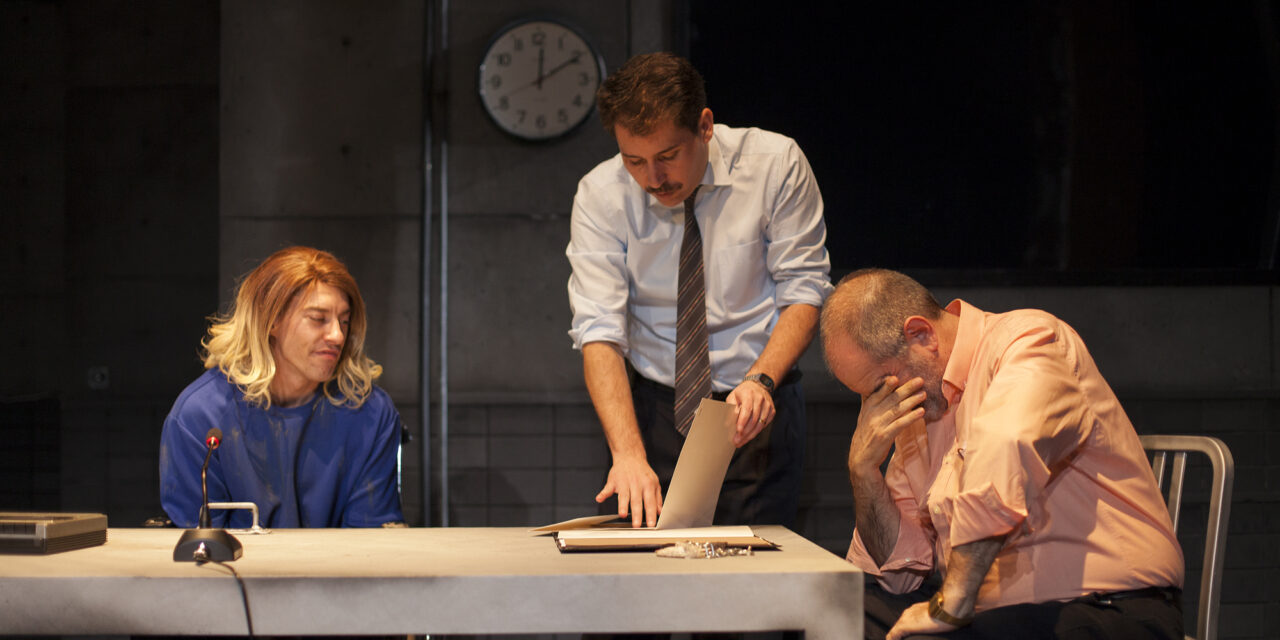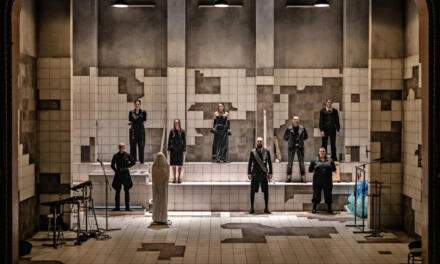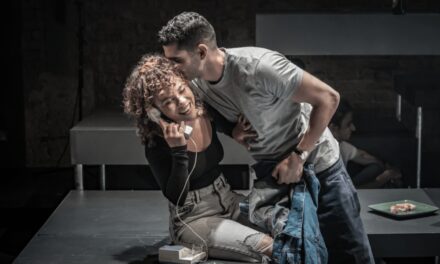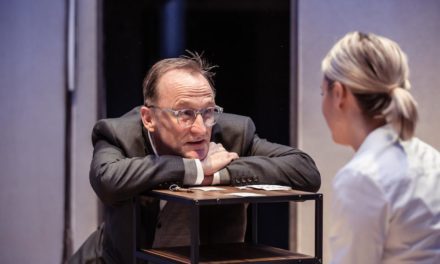Presented as a double bill alongside Jauría (English title Pack) at Madrid’s El Pavón Teatro Kamikaze, Port Arthur revisits a painful episode in Australia’s recent history. Martin Bryant was convicted in November 1996 of killing 35 people and injuring 29 others in a shooting spree at the historic open-air museum at Port Arthur, Tasmania on 28 April that year. Jordi Casanovas takes the eight-hour interrogation conducted at Tasmania’s Risdon Prison by two police officers on 4 July 1996 and edits it down to an 80-minute piece for three actors. The eight-hour interview is available on Wiki Leaks with a discussion by Carl Wernerhoff articulating concerns at the conviction—both the lack of witnesses and Bryant’s ability to plan and execute such a massacre alone. Casanovas offers no commentary to the transcript, edited with Silvia Sanfeliu, but simply allows for the convoluted narrative of the night in question to unfold through the policemen’s attempts to probe Bryant’s memory of what might or might not have happened that evening.
Alessio Meloni’s set delivers a bare grey room with small high windows and a clock on the back wall. The handcuffed Bryant (Adrián Lastra) is pushed on stage in a wheelchair. He is positioned at the table in the center of the room. The sound of the cell doors closing as the guard leaves Bryant alone in the room are deafening. The audience is left alone with Bryant. It’s an uncomfortable and long five minutes as he stares at us —the image recalls those used by the press in the aftermath of his arrest to present him as a deranged beast. He attempts to get up from the wheelchair and fiddles with his bandaged hands. A dull light from a lamp above Bryant’s head casts a dim glow on the table. Juan Gómez Cornejo’s lighting is as cold and grey as the walls of the room. Two video cameras stage-left appear to be recording the action in the cell. There are a tape recorder and a microphone on the table. Raised voices off stage are followed by the entry of the two plain clothes police officers, who each sit at one side of the table. Joaquín Climent plays John Warren, a veteran detective, while Javier Godino plays the younger Ross Payne. There is no good cop/bad cop scenario here, rather two policemen working in tandem to try and elicit a confession from a prisoner who doesn’t entirely understand what he is accused of.
Lastra’s Bryant is difficult to read. His face is framed by a head of course blond hair which he delicately picks out of his eyes, like a toddler. His eyes light up when asked about his collection of firearms and he chuckles mischievously when questioned about his failure to secure a firearms’ licence. There’s a childish but unnerving quality to both his high-pitched voice and his recurrent giggling. The repetitive behaviour and inability to pick up social cues point to possible autism—Bryant was diagnosed with Asperger’s in prison. He doesn’t appear able (or willing) to read the situation in the interrogation room, rather seeing it as something of a joke. An irritating laugh and bobbing head movements as he addresses each detective are followed by moments when he appears to sink into a dreamlike trance, or be caught unaware, like a rabbit in the headlights. His hands flap, his lip purse. He speaks of not wanting to be locked up but then smiles as if comfortable with the situation. It’s not easy spending 80 minutes in the company of Lastra’s unsettling characterization of Bryant.
The detectives display increasing frustration as Bryant refuses to provide a reason for the killings. Godino’s Payne removes his jacket and rolls up his sleeves as he presents the evasive Bryant with evidence. At times, he leans over him in exasperation. Climent’s Warren is more pensive but also displays his vexation and weariness at the lack of progress made with Bryant. They each take turns moving closer and then back away. The ticking clock shows the passing of time with blackouts moving the interrogation forward. It’s a race against the clock as the Warren and Payne try to elicit a confession from Bryant. It’s not clear whether the latter is suffering from amnesia—he appears to have no recollection of the events at the Blue Arrow Café, can’t be sure if he was in Port Arthur that evening and he doesn’t seem to concur with the information the two detectives offer about the timeline of events. All he really seems to want is a bucket of Kentucky Fried Chicken.
The cell may be spacious but the limited movement of the two detectives—facing Bryant across the table or circling him—contracts the stage into an increasingly claustrophobic space. The shadows cast across the floor by the screen at the back remains ominously black until the very end when footage of Bryant from 1996 provides an eerie doppelganger to the live image. David Serrano, best known for his work on Billy Elliott in Madrid, provides taut direction, opting for the assiduous pacing of a detective thriller. Will he or won’t he confess? What might be true? Has he been framed? It is edge of your seat stuff. As Warren and Payne question Bryant, the audience begins to piece together the different bits of a jigsaw of events that Bryant refuses to engage with. The detectives allege that he killed David and Sally Martin, owners of a guesthouse, Seascape, that his father had once sought to buy. Bryant appears to have held the Martins responsible for his father’s suicide in 1993. Bryant then travelled to the Broad Arrow Café where he appears to have shot 20 people dead, killed four more while escaping in his yellow Volvo, murdered three further pedestrians while leaving the area and then stolen a gold BMW after shooting its occupants. On driving away, he stopped by a couple in a white Toyota, forcing the male passenger into the boot of the BMW and then killing the woman driver. Bryant then took the hostage into the Martins’ guesthouse where he killed him before setting fire to the house. The bandaged hands that Bryant waves like stumps evidence his injuries from the fire. He was captured by police on attempting to escape the guesthouse.
That Bryant has both a limited IQ and learning difficulties are evident. There is no indication provided as to his motives. Is a psychopath? Did he have one or more accomplices? The lack of legal representation in the interrogation room and the change in gun laws that followed the massacre—a change that the Australian government had been seeking to implement for some time before the events of Port Arthur—serve to sow the seeds of doubt in the audience’s mind. The production’s efficacy in creating a climate of suspicion and mistrust rests on three terrific performances and an unfussy mise en scène where less is always more. Port Arthur hasn’t attracted the sell-out audiences of the highly topical Pack, but it too provides a site for asking questions of processes and narratives, and for thinking through how justice operates in public society—a pertinent issue in contemporary Spain.
Port Arthur runs at El Pavón Teatro Kamikaze until April 21.
This post was written by the author in their personal capacity.The opinions expressed in this article are the author’s own and do not reflect the view of The Theatre Times, their staff or collaborators.
This post was written by Maria Delgado.
The views expressed here belong to the author and do not necessarily reflect our views and opinions.


















